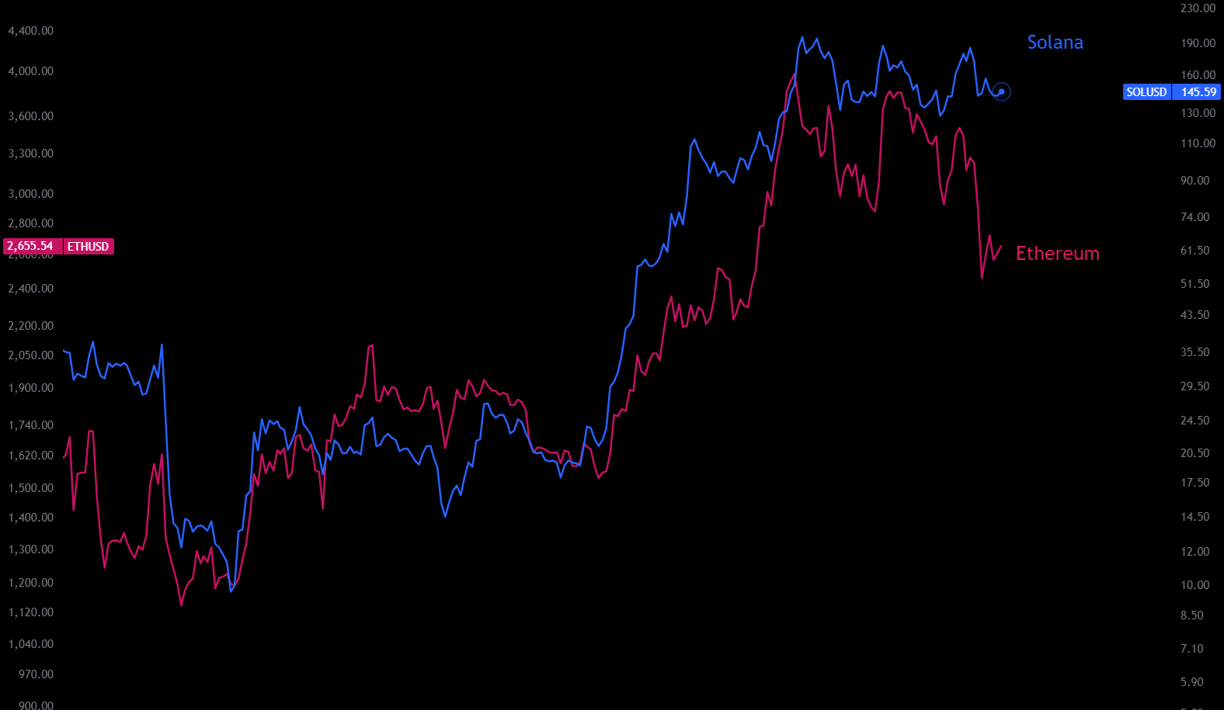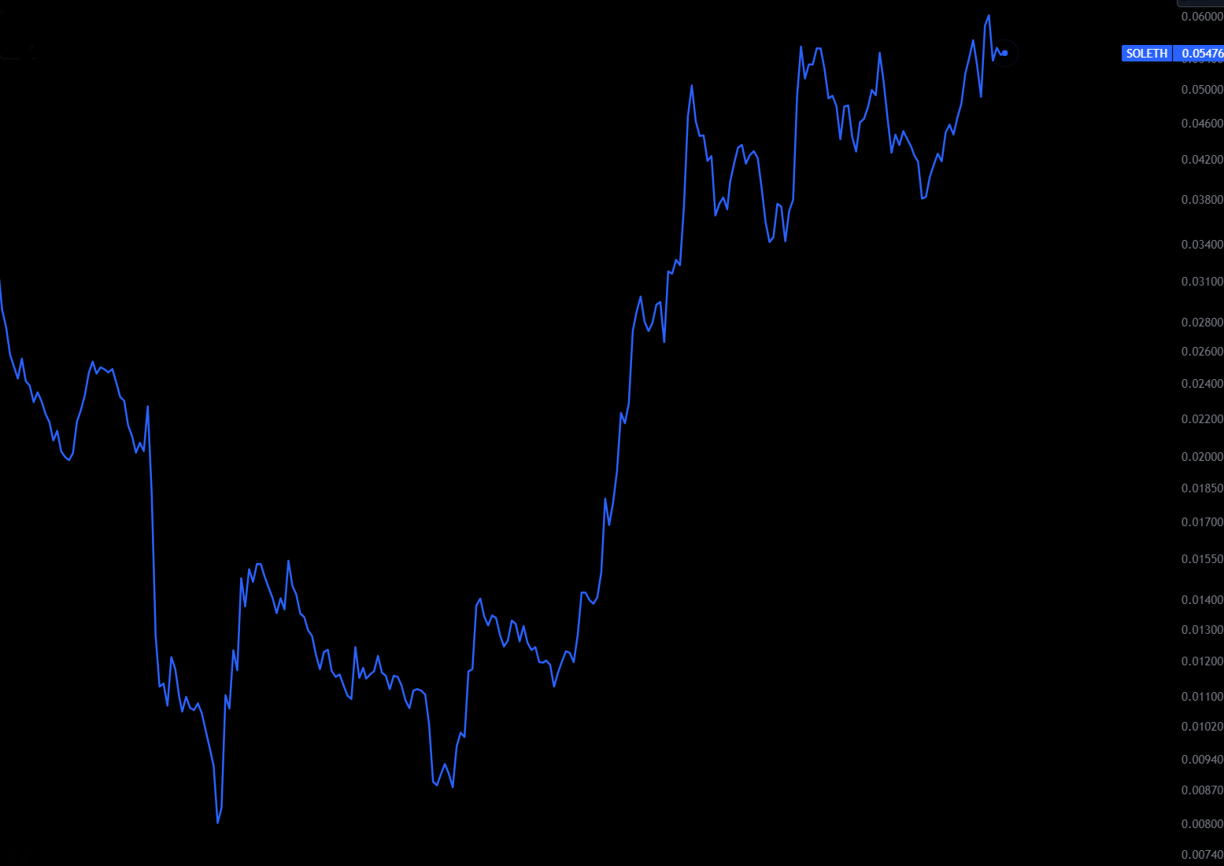How Solana Killed Ethereum: A Price Comparison
Learn about the price performance of Solana and Ethereum, and how Solana has outperformed in price, scalability, and market adoption despite network stability concerns.
MARKET INSIGHTS
8/20/20244 min read


Image via Grok
Disclaimer: This article is for informational purposes only and does not constitute financial advice. Always conduct your own research or consult with a professional before making any investment decisions.
The Changing Landscape of Layer 1 Blockchains
In the previous bull cycle, Ethereum experienced tremendous growth, solidifying its position as the leading altcoin and the dominant platform for decentralized applications (dApps) and decentralized finance (DeFi). However, as Layer 2 (L2) scalability solutions gained traction, L1 competitors emerged, positioning themselves as "Ethereum killers." Among these, Solana has shown significant potential, especially in terms of price action and scalability.
In this article, knowledge tree capital provides an in-depth analysis of how Solana has outperformed Ethereum in price and what this means for the future of blockchain technology.
Understanding Ethereum's Limitations as a Layer 1 Blockchain
Before diving into Solana's performance, it's essential to understand the challenges that Ethereum faces as a Layer 1 (L1) blockchain. Ethereum has long been the go-to platform for developers and projects within the blockchain ecosystem. However, it has struggled with scalability, network congestion, and high gas fees, particularly during periods of high demand.
These limitations have prompted the development of L2 solutions to improve Ethereum's scalability. However, Solana, with its unique consensus mechanism, has emerged as a strong L1 competitor.
Scalability and Transaction Speed: Solana vs. Ethereum
Scalability and transaction speed are critical factors in determining the success of a blockchain. One of Solana's most significant advantages over Ethereum is its scalability. Solana's Proof of History (PoH) consensus mechanism allows it to process transactions at a much faster rate than Ethereum. According to ChainSpect.app, as of 2024, Ethereum's average transaction speed was 12.81 transactions per second (TPS), while Solana achieved an impressive 731 TPS—57 times faster than Ethereum.
This fundamental difference makes Solana a more attractive option for developers and users alike, particularly in sectors like DeFi, where transaction speed and cost are crucial. Solana's ability to maintain low transaction costs and rapid confirmation times, even under heavy network loads, has contributed to its growing popularity.
The Trade-Off: Network Stability and Security
While Solana's speed and scalability are impressive, they come at a cost. Solana has faced several network stability issues that have raised concerns within the community. These issues stem primarily from the complexity of its Proof of History (PoH) mechanism and the relatively small number of validators on the network.
Complexity: The PoH mechanism, while innovative, creates bottlenecks under heavy network load, leading to synchronization issues among validators. This can cause slower network speeds or even halts.
Centralization: Solana's validator network is relatively small, and the technology required to validate the network can be expensive. This concentration of validators increases the risk of centralization and, consequently, network stability.




Disclaimer: This article is for informational purposes only and does not constitute financial advice. Always conduct your own research or consult with a professional before making any investment decisions.
Like what you're reading? Subscribe to our newsletter to get premium insights on the market
Price Action: Solana vs. Ethereum
The price action of Solana and Ethereum has been a key area of interest for investors. At the beginning of 2023, Ethereum was seen as a stronger asset, particularly in the wake of fears surrounding an FTX sell-off that led to a sharp decline in Solana's price. However, as the market reacted to the rise of memecoins on Solana, its price began to surge toward the end of 2023.
Analyzing the price charts, it's evident that Solana's price movements were more pronounced and stronger than Ethereum's during this period. Solana experienced shallower price retracements, indicating greater investor confidence. In contrast, Ethereum's price action has shown deeper retracements and flirts with invalidating bullish structures.
Despite this, Ethereum remains the largest altcoin by market cap and continues to be a significant player in the crypto space.
Comparing Solana to Ethereum in Relative Terms (SOLETH)
An important metric to consider when comparing Solana to Ethereum is the SOLETH chart, which represents Solana's price in terms of Ethereum. This chart provides insight into Solana's performance relative to Ethereum, and the results have been remarkable. Since 2023, holding Solana relative to Ethereum has produced an approximate 665% gain.
This performance suggests that, despite network stability concerns, investors and developers have been willing to overlook these issues in favor of Solana's superior network performance.
Future Outlook: Can Ethereum Outpace Solana?
While Solana has outperformed Ethereum in recent price action, it's important to note that Ethereum's long-term resilience cannot be understated. Having survived two bull cycles, Ethereum has proven its ability to adapt and evolve. With continued investments in L2 technologies to address scalability issues, Ethereum remains a formidable competitor.
The SOLETH chart implies that, at some point within the current bull cycle, Ethereum may outpace Solana, offering more potential returns. However, this does not diminish Solana's potential for further price appreciation in USD terms
Conclusion: A Bullish Outlook for Both Solana and Ethereum
At Knowledge Tree Capital, we maintain a bullish outlook on both Solana and Ethereum. Both blockchains offer unique advantages and have proven to be valuable assets within the crypto ecosystem. As we move forward in this bull cycle, it will be fascinating to watch how these two giants continue to evolve and compete for dominance in the market.

